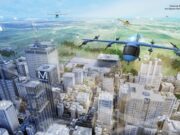The U.S. Department of Transportation (DOT) has delayed until December the planned publication of a notice of proposed rulemaking (NPRM) on a system calling for the remote identification of drones.
Remote identification (remote ID) refers to the ability of drones — also known as unmanned aircraft systems (UAS) and by several other names — to provide information while in flight on their identification that can be received by other parties, specifically law enforcement authorities and the U.S. Federal Aviation Administration.
Remote ID is intended to “address security and law enforcement concerns” associated with the integration of drones into the National Airspace System (NAS) while also “enabling greater operational capabilities by these same aircraft,” DOT said in its monthly report on significant rulemaking action.
The NPRM, which had been expected in May and was postponed twice, first until July and then until September, is now projected to be published Dec. 20.
The drone industry considers publication of the rule a crucial step in providing for more advanced commercial drone operations and in integrating drones into the NAS.
Brian Wynne, president and CEO of the Association for Unmanned Vehicle Systems International, said the delay was disappointing.
“The need for remote identification cannot be overstated, as the advancement of the UAS industry depends on identifying and tracking UAS flying in the airspace,” Wynne said. “Remote ID is necessary for enabling advanced and expanded operations such as flights over people and beyond line of sight, which will provide significant benefits throughout our economy and society. Most importantly, remote ID is critical for ensuring airspace safety by helping law enforcement identify and distinguish authorized UAS from those that may pose a security threat.”
Wynne said that his organization urges the FAA to “move as quickly as possible with rulemaking for remote identification to keep the skies safe for all aircraft — both manned and unmanned.”



